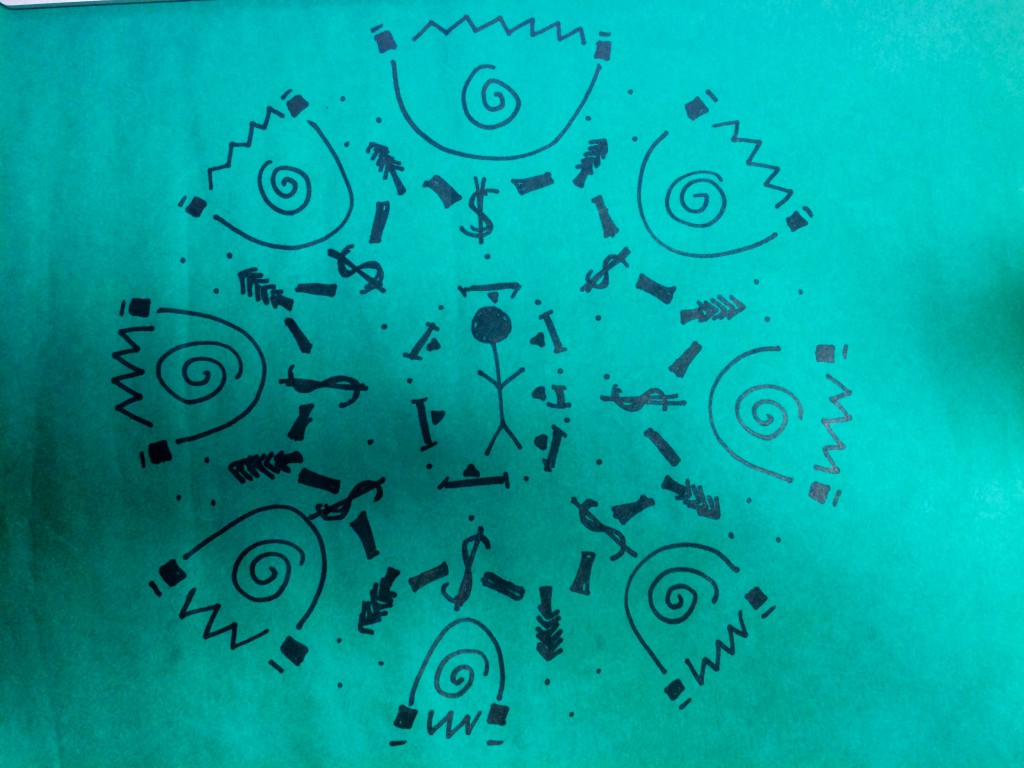
“What do you know? What do you want to know? What does the community need to know?”
I am working on the Community Economic Development Strategy Update for the Cascades West Council of Governments, and these were the questions posed to us recently in Community Planning Workshop class. We were asked to use a piece of colored paper to create a map of our work process.
I looked around to see many of my peers writing out notes in consternation, folding their papers to organize the material. I hadn’t had any coffee yet. I couldn’t think of anything to write. So I started drawing.
The only thing I know right now, at 8:30 in the morning, is myself and how I relate to people, I thought. So I drew a person in the center.
I want to better understand how economics and the environment relate to each other, I decided. So I drew dollar signs and pine trees.
And what does the community need to know, I wondered? How to be open to ideas, I thought, and drew some wide, welcoming arcs. And how to mix ideas- spirals, and how to deal with the rise and fall of conflict- sharp ridges.
All of these qualities are the building blocks of a team, I resolved, and added some dark blocks at the ends of the arcs. Coming out of my head, I blinked and looked down at my paper.
What could have been a map, was instead symbols forming a sort of mandala- a sacred image in Eastern religion representing the universe, and all the pieces that balance inside it. While not an intended product, this mini-universe made more sense to me than a map. Balancing what we know, what we want to know, and what the community needs to know is at the heart of all work that strives to do good. How can we, as planners and citizens, balance the social, economic, and environmental factors that can contribute to a better world?
Looking at my paper, I realized part of CPW, and grad school, isn’t about maps, while they can be useful. Maps lead somewhere. They are a linear set of directions that take us to where we’re trying to go. Once we get to those places, we need new maps.
Instead of seeing CPW as single team projects, following their own maps, I see each one as small symbols creating a bigger picture. I know that not every project will be awe-inspiring, or thrilling. But every project, like a symbol in a mandala, contributes to what we see when we stand back: a universe of communities trying to better serve the land, and the people who inhabit it. A universe of communities trying to do good.
While my team jokingly suggested using this image as our team logo, I think the concept has some validity: don’t create a map you want to follow. Create the universe you want to live within.
 About the Author: Kelsey Zlevor is a Master’s in Community and Regional Planning student, and a newly-minted Oregon transplant from Chicago. A former environmental scientist from University of Iowa, she now works at Sustainable Cities Initiative on campus, helping facilitate environmental work in Oregon communities. Outside of class, Kelsey also identifies as a coffee addict, Iowa-enthusiast, speed walker, and cellist.
About the Author: Kelsey Zlevor is a Master’s in Community and Regional Planning student, and a newly-minted Oregon transplant from Chicago. A former environmental scientist from University of Iowa, she now works at Sustainable Cities Initiative on campus, helping facilitate environmental work in Oregon communities. Outside of class, Kelsey also identifies as a coffee addict, Iowa-enthusiast, speed walker, and cellist.
